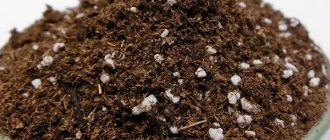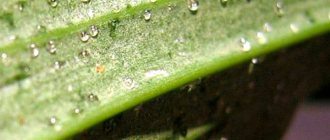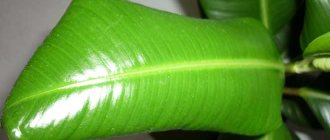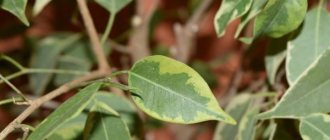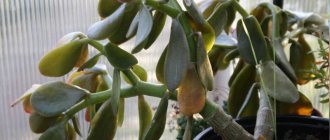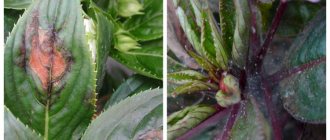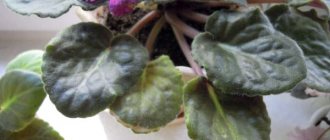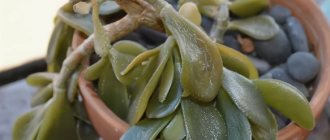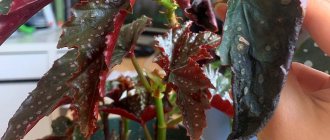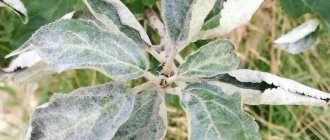Ficus diseases appear if the conditions of maintenance and care at home are violated. The growth of home ficus does not require complex care. In a modern apartment he feels great, but is still susceptible to many diseases. It is important to correctly identify the problem in order to choose the appropriate treatment method. Ficus diseases appear due to lack of prevention and unfavorable external factors (extreme heat, excess humidity). Often a flower becomes infected from nearby plants.
Why are ficus diseases dangerous?
Diseases of Ficus Benjamin can significantly damage the plant, and in some cases even destroy it. What should you do if your ficus leaves turn red or have white spots, mites, aphids and white or red dots? You need to act immediately. If you do not purchase special medicinal products in time and do not rid the sick houseplant of pests and diseases, as well as white lumps, it may simply die.
In addition, what is dangerous about an invasion of parasites is that it increases the risk of a similar problem occurring in your other evergreens. Study the most common diseases of ficus, determine the source of the outbreak of the flower disease, and then proceed to full treatment.
Infections and fungal infections
Proper care will keep any plant healthy. But sometimes even he is not able to get rid of unwanted problems that arise due to the diligent care of the gardener. Ficus diseases also occur due to external factors: initially hidden diseases in newly purchased plants, cuttings, when replacing the soil mixture or transplanting into open ground.
Infections and fungal infections of ficus
Attention! Even prepared soil purchased in a store does not always guarantee that conscientious manufacturers have disinfected it from ficus pest larvae.
The most common diseases of any type of ficus genus include:
Powdery mildew
White spots that look like a fluffy coating that are easily erased.
Reason: from direct sunlight, places damaged by insects, subsequently infected with fungus. Treatment: The plaque is washed off with a sponge soaked in soapy water. Severely affected leaves are removed. The plant is treated with a fungicide.
Anthracnose or rust
Uneven, rusty spots with a brown border along the edge of the leaf. After some time, holes form in their place. Later the leaves completely darken and die. Cause: Fungus Colletotrichum orbiculare. Treatment: Diseased areas are cut off, the ficus is treated with fungicide and copper oxychloride.
Causes of the disease
Sometimes ficus trees can develop various kinds of diseases. They usually occur due to improper or negligent care. Pests emerge from contaminated soil, quickly attacking the roots and destroying the plant. Or the flower may freeze and die from fungi and other related infections.
The main causes of ficus diseases:
- temperature imbalance;
- excess or deficiency of air humidity;
- untimely or frequent watering;
- lack or oversaturation of essential microelements.
Ficus is never placed near a heating radiator. If heating devices are located nearby, then a moistened cloth is placed on them and on the windowsill for protection, and the surface of the flower is often sprayed with small drops. If the humidity, on the contrary, is high, then it is advisable to wait until the soil dries 2-3 cm, and then continue watering.
You should beware of extreme heat and excessively dry air, strong drafts and gusts of wind. You cannot spray ficus and then place it in the sun - you can cause the leaves to burn.
If the grower takes diligent care of the plant, then the risk of disease is minimized. However, sometimes cuttings and young stems may have hidden diseases that are not noticeable at first glance. Infections and parasites (for example, nematodes) are introduced from the soil. Ficus often dies from them.
It is recommended to fertilize ficus in the warm season - once every two weeks. With the onset of autumn, they feed less often; in winter there is no need to touch the flower. Nourish the soil according to the instructions on the package so as not to overfeed. The leaves also react to excess feeding - dots and specks appear on them.
If rot appears at the base of the root, the leaves wither and curl, the culprit is most likely constant flooding. If the ficus stops growing, the soil is depleted and mineral resources are running out.
Leaf diseases
Why do ficus leaves fall off? There may be several reasons why the plant is sick. Among the most common diseases of the leaf blade of the home ficus, the following are worth highlighting.
If the leaves begin to wither and curl inward, this is the first sign that the ficus is sick. The appearance will clearly show the reason why the infection occurred. Leaf blades may look like this.
- Brown. Demonstrate a state of stress as a result of transplantation.
- With reddish spots. Several reasons: in most cases - sunburn, as well as increased watering and drafts.
- With brown spots. Insufficient watering and dry air, exposure to heat, excess fertilizer in the soil. Plaques of this color along the leaf veins indicate infection by parasites.
- Covered with gray coating, cobwebs and white spots. Mites, thrips larvae, beginning gray rot.
- Yellow edges with small white dots. Excessive watering, excessive humidity.
The leaves are turning yellow
As a rule, this problem occurs in winter. Heating devices are actively working in the apartment, and hot air flows are often directed at indoor plants. For a sick ficus, this factor will be disastrous. The leaves begin to turn yellow, wither and gradually fall off. When a flower sheds its leaves en masse, it stops growing and may die.
The best solution for you is to move the flowerpot with the evergreen specimen to another, much more suitable place. However, be careful when looking for a new corner to place your ficus pot. If you disturb it too often, the yellowing of the foliage may begin again, but this time the ficus will get sick due to the stressful situation you created.
Another reason for yellowing leaves is burns caused by direct sunlight.
How to save a plant from this?
- In summer, the flower should not be exposed to direct sunlight for a long time.
- In winter, it is better to relocate it to places far from the batteries.
To humidify the air, use a container of water near the plant.
Leaves fall off or become small
Such ficus diseases also pose a serious danger to the plant, so they must be treated as quickly as possible. The diseased plant gradually withers, and the reason for this is a lack of nutrients in the soil. The situation can be corrected. To do this, it is necessary to replant the plant, completely replacing the soil composition;
The tips of the leaves turn yellow, yellow spots appear
This problem indicates an excess of moisture in the soil. Do not forget that ficus loves moisture, but watering should be moderate. Be sure to let the soil dry before irrigating the substrate again. For an indoor flower, a lack of moisture will be much less destructive than its excess.
It is urgent to dry the soil and review the watering rules. Ficus does not tolerate stagnation of water in the pan. Drafts and, in general, any sudden change of environment are harmful to him.
Ficus sheds leaves from below
This reason is considered natural - each ficus leaf blade develops within three years, and then ages and falls off. However, the trunk cannot be completely exposed, since in this case it will be very difficult to save it. If you observe the fulfillment of unsuccessful forecasts, it’s time to replant the flower or add complex mineral fertilizers to the soil;
Why does ficus shed its leaves completely?
The main reason for dropping leaves is overdried soil or watering with poor quality water. If a ficus sheds its leaves due to a lack of water, then its root system is also not in the best condition, because it is directly related to nutrition and water balance. In this case, you need to water it generously and subsequently monitor the quality and frequency of watering.
Ficus tree varieties tend to fall off the leaves of the lower part of the trunk , but this is not a disease. In general, the bush itself never becomes bare, but on the contrary produces more and more new leaves. Ficus leaves may fall off in other cases. The flower is either affected by an infection or by some pest. In such cases, treatment with special preparations is necessary.
Pests on ficus leaves
As a result, the leaf blade dies sooner or later if treatment is not taken. You can get rid of pests with the help of special insecticidal preparations, which you need to buy in the store.
Ficus doesn't grow
The following external symptom can also indicate a problem with the soil: the leaves begin to grow smaller and smaller and eventually the ficus stops growing altogether. Most often this occurs due to soil depletion . When the moment comes that the soil is depleted of all useful resources, the recently blossomed ficus leaves begin to gradually become smaller in mineral components, and their predecessors turn yellow, wither and fall off.
To return the plant to normal functioning, it is necessary to replant it or replace the soil. The substrate must be saturated with the necessary mineral complex and vitamins. Stores now sell soil specially prepared for ficus.
Spots on Ficus leaves: causes and treatment
Ficuses are unpretentious plants that do well at home. However, sometimes due to improper care or proximity to infected flowers, ficus trees can get sick. There are several reasons why ficus has spots on its leaves.
Spots on ficus leaves
Causes of spots
The appearance of brown spots on a ficus usually means that the flower is infected with something. But there are other factors that cause rusty, dark or light spots on ficus leaves . This process can determine the age of the flower and its location in the apartment. Reasons also include:
- poor-quality lighting, due to which the bush does not receive enough ultraviolet radiation;
- a small percentage of air in the room, due to which the root system does not receive the required percentage of oxygen;
- improper watering;
- lack of nutrients;
- poor-quality soil (the crown becomes sticky and becomes covered with yellow, white or brown spots).
- improper watering: you must not dry out the soil in which the ficus grows or over-moisten it.
It is best to place the pot in a sunny place, since the ficus is light-loving. In this case, direct sunlight must be avoided so that the plant does not get burned.
Pests and diseases are another problem that can cause yellowing of the crown, black spots on the leaves or brown spots on the stem and leaves of the ficus.
Stains and yellowing
Yellow leaves appear due to low humidity in the room. Most often, this phenomenon is observed during the cold period: the room is heated, due to which the air dries out greatly.
The plant can suffer especially severely if it stands next to a device that produces heat (fan, battery). This is the reason why during the heated period the flower pot should look for another place.
The leaves may also become sticky.
Dry air is bad for leaves
Another precaution is to regularly spray the leaves with a spray bottle. If the plant has already been damaged, in order to revive it, it must be sprayed every 6 hours.
The second factor that can affect the bush is the stress it has experienced. To avoid this effect, it is advisable to find the optimal location for the pot, rather than drag it from place to place.
Leaf fall
If the leaves and stem of a flower begin to turn yellow and then fall, the root system lacks nutrients and microelements. In such a situation, there is only one way out: transplant the flower into a new pot. You should purchase soil with a peat base, leaf soil and, of course, sand.
Falling yellow leaves may also indicate that there is too much water in the soil, which means that the root system takes in too much water and eventually begins to rot. To prevent this from happening, the soil should be watered only when the soil dries at least 3 cm from the surface. If you give the plant too much water, it may dry out.
If the leaves begin to fall off very much, the flower must be urgently replanted, but before this it is necessary to cut off all dead and rotten roots and allow them to dry.
Falling leaves at the bottom of the trunk
If the leaves have fallen at the bottom of the trunk, the bush is already aging.
If the ficus is young, but has begun to lose leaves from the base of the stem, the transport standards have been violated. To restore a flower, it should be transported to new soil.
Infectious diseases
If various pests appear on the leaves of Ficus Benjamin, you can fight them quite effectively, especially if you noticed the problem at an early stage. But if you are faced with infectious diseases, it is much more difficult to cure the plant from them.
The first signs are difficult to notice, and when a flower is seriously ill, even the most effective methods do not always give the desired result. To defeat infectious diseases of ficus plants, it is necessary to take a closer look at what plant ailments a domestic gardener may encounter, and what to do in this case.
Why does the leaf become stained?
Spots on ficus leaves arise due to the gardener’s unscrupulous care for the plant, as well as due to the activity of the fungus and parasites that attack it.
The photo shows spots on ficus leaves
Let's look at the reasons for the appearance of uncharacteristic patterns and colors of foliage, which are most common:
| Color | The root of the problem |
| Brown leaf color | Characteristic of some types of ficus. The plant may have suffered stress after transplantation. |
| Brown spots | Increased temperature and dry air. Overfeeding with mineral fertilizers. |
| Reddish-brown spots | Sunburn. Exposure to draft. Excessive watering. Infestation by fungus or parasites. |
| Brown plaques along leaf veins | Scale insect infestation. |
| Brown spots resembling strokes in shape | Thrips infestation. |
| Small yellow dots, yellowish leaf edges | Overflow. |
| Red dots, whitish coating | Leaf damage by thrips larvae. |
| White or grayish spots, cobwebs | Spider mite infestation. |
Ficus foliage burns photo
Fungal diseases
Fungal diseases of ficus are considered the most dangerous for the plant. If pests of Ficus Benjamin are removed using high-quality insecticides, in some cases a green specimen affected by a fungal disease cannot be saved even by an experienced gardener. What specific ficus diseases fall into this category is worth studying carefully.
Anthracnose or rust
Along the edges of the leaf, rust-colored spots with a brownish border are visible. The damaged part dies, forming holes in the leaves. Then they darken and fall off. The infection is caused by a fungus called Colletotrichum orbiculare.
Pests are controlled by spraying the roots and stem with a fungicide. It is also used to treat surfaces with “ulcers” from rust.
Powdery mildew
Causes white plaque-like spots. Occurs in areas of pest damage and fungal infection. Plaque also appears from strong light exposure.
- To get rid of powdery mildew, laundry soap alone is not enough. You will also need copper sulfate and soda ash. Prepare a medicinal solution by mixing a teaspoon of soda and two grams of soap in a liter of water. Separately dilute 2-3 grams of copper sulfate. Combine everything together, add another liter of water and spray the affected parts with this mixture.
Botrytis
A gray coating consisting of small spores of the fungus Botryotinia fuckeliana. The spots gradually become darker, then the leaf blades fall off the stem.
Sooty mushroom
The lesion looks like a black coating similar to soot. The reason is an active attack by insects. Their sticky secretions feed fungi that silently multiply on the foliage.
- Black plaque indicates a double lesion. Sooty fungus occurs as a result of insects. A concentrated soap solution will prevent the spread of fungus. If the leaves are severely affected, it is better to remove them.
Cercospora
Caused by fungi of the Cercospora family. Visually, the manifestations of the disease look like brown and grayish dots on the underside of the leaf. Then the dots become much larger, and the leaves turn yellow and fall off.
Cercospora and anthracnose require treatment with special antifungal drugs.
Such an infection cannot be started; urgent measures must be taken. The ficus may not survive and dry out completely. Treatment of fungal infections is carried out immediately with special means.
Late blight, pythium or rhizoctonia
Dangerous fungi that cause rotting. It is better to throw out or destroy an infected ficus to keep nearby plants healthy.
Gray rot
Among the diseases of the house ficus, which are the result of the activity of fungal formations on the flower, it is worth highlighting first of all gray rot. The key sign of the disease is blackened leaves, which eventually fall off. As a rule, the disease appears due to excessively high humidity in the room. In the fight against this disease, it is necessary to reduce the frequency of watering and also ventilate the room more often.
- If gray rot appears, then it is necessary to immediately remove the infected leaves. The soil at the roots should dry well. This should help revive the plant. It is also recommended to replace the soil and replant the remaining roots in clean soil.
Sooty mushroom
Treatment of black plaque (and this is a key sign of the disease) may be necessary after the plant has been attacked by harmful insects. The initial stage of fighting the disease involves washing the flower with soapy water. Soak a sponge in the liquid and carefully go over each leaf. The stem must also be treated with a fungicide. As a preventative measure, do not overwater the flower in the future. Irrigating the substrate with a solution of manganese will not hurt either. It is advisable to carry out this procedure at least once a month.
Fungi on leaves
Among the fungal formations that mostly appear on leaf blades, it is worth highlighting cercospora, anthracnose, and botrytis. As such diseases develop, black, yellow or brownish spots develop on the leaves. If you don’t fight them, the same result awaits you: the death of the leaf blade.
The disease must be eliminated by removing the affected parts and treating the plant with a fungicide.
Brown spots appeared on ficus leaves - causes and treatment
Ficus is one of the most popular indoor plants; many housewives simply adore it. And this is not at all surprising, because caring for this tree is not at all difficult; in addition, it looks impressive and will fit perfectly into any interior.
But, like any other plant, ficus is susceptible to various diseases, one of the most common of which is darkening of the leaves. Many women wonder why brown spots appear on ficus leaves and how they can cure their “pet.”
After all, if you leave everything to chance, this disease can even lead to the death of the plant.
Be careful when purchasing
It’s worth noting right away that ficus is a fairly unpretentious plant and with proper care you should not have any problems with it.
If you have just decided to acquire this beautiful tree, carefully inspect it before purchasing. After all, sometimes in stores plants simply do not receive the attention they deserve, and, in addition, they may simply be stored incorrectly.
Such a neglectful attitude often provokes the appearance of all kinds of ailments, as well as the appearance of fungus.
In order not to make a mistake with your choice, you will need to examine the leaves not only from the top side, but also from the inside.
If you notice even minimal signs of disease, discard this plant, because it is likely that you simply will not be able to grow it. In addition, the infection can be transmitted to other plants, and you probably don’t want that at all.
Various damage and new growths on the leaves should also alert you, as they also indicate that the plant is sick.
Improper care
If brown spots appear on the leaves of the ficus, then the most likely reason is that you are simply keeping the flower in unsuitable conditions. Here are the most common mistakes housewives make:
- The plant is not recommended to be placed near heating devices and radiators , since due to the increased temperature its leaves will soon begin to dry out;
- you are feeding the plant with the wrong fertilizers. As surprising as it may be, an excess of minerals can also provoke various deviations, since the tree simply will not absorb them properly. If you think that complementary feeding is still necessary, keep in mind that it can be used no more than once every 15 days, and it is better to give preference to those species that contain a large amount of nitrogen;
- ficus needs moderate watering , but many housewives simply water it periodically. And after such indiscretion, the leaves begin to become covered with brown spots. If this does happen, then in order to save the flower, you will need to replant it. At the same time, carefully examine the roots; if they are damaged somewhere, the affected areas will have to be carefully cut off and then treated with activated carbon;
- Drafts also contribute to the appearance of darkening , so it is better to keep the ficus in a protected place.
Possible diseases
If you are sure that you are not making mistakes in care, then your pet is most likely just sick. Here's what you might encounter:
- spider mite In this case, yellowish-brown spots and yellow dots will begin to appear on the inside of the leaves of the ficus. And if you look closely at the plant, you will be able to see the small cobweb itself. In order to eliminate the disease, you will need to wash the leaves with a solution that can be purchased at any specialty store;
- gray rot. This fungus is quite rare and only certain types of plants are susceptible to it. This disease is characterized by the appearance of gray mold on the leaves, due to which they begin to darken and then die completely. To remove the attack, you will have to tear off the affected leaves and treat the flower itself with insecticides;
- scale insect and false scale insect. When it occurs, the plant may grow poorly, and brown spots may appear on the leaves, and they will also be sticky in some places. The plant trunk itself is often covered with this coating. It is advisable to eliminate this disease in the early stages, before it destroys your favorite ficus;
- fungal infections. They can be caused by inappropriate pot location or improper care. You can get rid of the scourge only if you tear off all the affected leaves and do not spray the plants for some time;
- Root rotting. It is most often provoked by excessive watering; in this case it is almost impossible to save the tree. The only thing you can try to do is replant the plant.
Treatment
If you notice that at least one spot has appeared on the plant, you need to start treating it as soon as possible. You can use both purchased and folk remedies for this. Of course, the best option is to purchase a high-quality insecticide (from any manufacturer) that will eliminate the problem in the shortest possible time.
And if you prefer traditional methods, then you will need to use a copper-soap or fungicide solution.
To prepare it, simply grate 20 grams of soap and dissolve the resulting shavings in a liter of warm water, then dilute 3 grams of copper sulfate in a separate container and mix the liquids together.
This solution will need to be treated daily with ficus leaves both on the outside and on the inside. This is all done until the darkening goes away.
Now you know why ficus leaves become covered with dark spots. From all of the above, it becomes obvious that it is still possible to remove this scourge. The main thing is to get treatment in a timely manner and approach the problem wisely.
Source: https://HozInfo.ru/rasteniya/na-listyah-fikusa-korichnevye-pyatna
Root rot
If a ficus gets sick with root rot, it means that you did not follow the plant’s watering regime at one time. In this case, the root system begins to actively rot, and the stems and leaves wither, gradually losing their brightness and acquiring a grayish color.
Interestingly, if the infection gets into the soil, it may not spread to the flower for some time. But sooner or later this will happen, and then the only correct solution will be to throw the plant and the pot in the trash.
Pests attacking a plant
Spider mites on ficus, thrips on ficus, mealybugs - all these parasites can cause a lot of harm to your green specimen. For example, an invasion of spider mites is not immediately noticeable. It is quite difficult to detect parasites on a flower when there are only a few of them.
Nematodes penetrate the root system and cause the appearance of nodular and spherical growths on the trunk. The toxins released by these parasites gradually affect the entire plant; it needs to be cured and replanted in new soil. Before the procedure, the ficus is kept in an insecticide solution for several hours, completely eliminating dangerous infection.
Aphid
You can become infected with aphids from the air; they are carried in by drafts. A sticky whitish coating, similar to flour, appears on the foliage. It feeds on sooty fungus, which is dangerous for the bush. If there are several bushes, the infection spreads quickly.
- If there are aphids in the house, they often infect not one, but several plants at once. We will have to resort to a comprehensive refurbishment of the premises. Insecticides are used, in addition to the standard treatment with potassium permanganate and soap.
Shchitovka
It reproduces in trays under plants, where water often remains. The insect sucks the juice from the foliage, depriving it of vitality. The presence of “swollen” brownish spots is a consequence of the introduction of scale insects.
- If you notice an insect such as a scale insect, then you need to use the drug "Actellik". It is recommended to treat the plant with it at least three to four times a week. It is also often necessary to wipe the leaves with a soap solution.
Mealybug
Dangerous parasites that can suck all the strength from a plant and lead to death. Individuals reach 4-5 mm, their white cocoons and adult parasites are clearly visible on the ficus. The first sign of its appearance is the rapid fall of leaves.
Mite
Causes serious damage to ficus. Loves heat and lack of moisture. Leaves behind a barely noticeable cobweb and grayish-brown spots. The leaves begin to dry out and fall off.
- Experienced gardeners suggest getting rid of swarms of ticks by using garlic tincture. To prepare it, take two heads of garlic. They are finely chopped and poured with a liter of boiling water. Place in the dark for 5 days, after which the same amount of water is added. You need to spray the inside of the leaves and stems, as well as the soil.
Thrips
Their effect on the plant is similar to the introduction of mites. Insects suck out vital juices; their comfortable environment is high temperature and dry air. They leave brown spots, causing the leaves and stem to dry out.
But a huge colony of ticks is more difficult to fight. That's why it doesn't hurt to regularly inspect the flower to look for mealybugs or aphids on the stems and leaves. If aphids appear on a ficus, how to deal with them? Buy effective insecticides and carefully treat the flower.
Mealybug - treatment of indoor flowers
First, using a soft brush or cotton swab dipped in soapy water or an alcohol solution, we mechanically clean the plant of scale insects and the white cotton-like secretions they form (the majority of the eggs and larvae of scale insects are found in these secretions).
When ridding plants of mealybugs, we recommend using effective chemicals rather than traditional methods.
In case of severe damage by scale insects, in addition to manual destruction, spray at intervals of 7-14 days with one of the following preparations: Aktara, Biotlin, Fufanon, Calypso, Confidant, Confidor, Mospilan.
Each of these drugs has instructions that must be strictly followed. If you add little of the drug to the sprayer, there will be no therapeutic effect; if you add too much, the leaves may burn. When treating diseased plants with mealybugs in indoor flowers with actara, it is necessary to spray the plants with it and spill the remaining solution into the soil! Don’t forget that there are also insect eggs in the soil.
Add green soap to the sprayer with the drug diluted in it; it can be purchased at a flower shop. For a liter sprayer, it will be enough to add 2 tablespoons of soap. Green soap will help the drug not to drain from the leaves, but will retain the drug on the plant and prolong the effect of the chemicals on the mealybug.
In affected plants, after the first or second treatment, you need to change the top part of the soil to remove the remains of dead insects.
Be sure to shed the soil from the worm, otherwise there will be no result!
And remember: the drugs have a strong, unpleasant odor, so wear a medical mask when working. Children and pets should be kept away from the flower treatment area. The smell from the drug can last for 2-12 hours.
A few hours after spraying the plants, you can ventilate the room.
Ficus benjamina diseases
This species is popular due to its beautiful glossy leaves and stems that can be intertwined. Grows up to 3 meters high with proper care.
Causes of ficus disease:
- Improper care;
- Fungal infection;
- Reproduction of pests.
Due to improper care, problems appear in the form of root rot and the appearance of spots on the leaves.
Root rot develops due to systematic waterlogging of the soil. In a humid environment, a fungus develops that affects the roots. This causes the leaves to change color to yellow and become limp. Within a short time they darken and fall off. The soil may become crusty. As a result, the plant dies.
How to treat it? Pull the flower out of the pot and shake it lightly, clearing the roots from the soil. If they are dark and soft, the plant is dead and nothing will help it. When the main part of the roots is healthy, you need to trim off the spoiled roots. You also need to rid the crown of diseased leaves and branches. Replant the plant in a new pot with fresh soil.
You can water the flower only after new leaves appear and then maintain the watering regime.
Light brown spots may appear localized at the tips, along the edges or throughout the entire area of the leaves. Then they dry out and fall off. This is caused by too high a temperature and dry air. This often happens due to an excess of fertilizers in the soil. Eliminating the causes of its occurrence will help get rid of the problem. It is necessary to place the plant in a cooler place, increase air humidity and postpone fertilizing the soil.
There are other problems associated with pests and infections.
If rust appears on the leaves of Ficus Benjamin , then the problem is the fungal disease Anthracnose. Botrytis is similar, but in this case the spots become yellow-brown in color. Over time, the spots turn into ulcers, the plant sheds its leaves and dies. For treatment, it is necessary to remove all affected leaves, treat the ficus with a fungicide solution and move it to a less humid place.
Fungicides are chemical solutions used to control fungus on plants. They also treat seeds to remove fungal spores. The concentrate of the substance is toxic to humans, but a properly prepared solution will not cause harm.
Cercospora blight is another fungal disease that appears on ficus as numerous black spots on the bottom of the leaf. As the disease progresses, they turn yellow and fall off, and the plant dies. Treatment according to a similar scheme: remove the affected areas, treat with an anti-fungal solution, water less often.
Sticky leaves and black coating are a progressive sooty fungus on Ficus Benjamin. It affects areas with waste products of parasites. The scale insect on Benjamin's ficus leaves behind a sticky trail on which it settles. Cleaning with soapy water will help.
White coating on the leaves indicates mealybug . At the initial stage, a solution of laundry soap will help; if the flower is severely affected, then the diseased leaves are removed and the ficus is treated with a fungicide.
When a ficus grows in a warm and humid room, it can be affected by gray rot . This is mold, if you shake the leaf, you can see how its spores fly away (they look like gray dust). Brown spots appear on the foliage; if no action is taken, they grow. The leaves darken and fall off. This disease is treated with a solution of an anti-fungal drug. You need to water the flower less often during treatment.
Brief characteristics of the plant
The tree has another name - elastic (Ficus Elastica), belongs to the Mulberry family. In the 19th century it was grown for rubber production. Its homeland is India and the southern part of Indonesia from the islands of Sumatra and Java, where it grows into a tall tree, almost up to 30 meters, and is revered by local Buddhists as sacred, and in indoor conditions it rarely grows above 2 meters.
In its natural environment it is able to grow in the Mediterranean; in more northern latitudes it is grown only indoors, since it is not resistant to low temperatures.
The most famous species found in gardeners’ homes include:
- Belize. They have light pink or white patterns along the edges.
- Variegata. The leaves are thin, feathery, the streaks on the leaves are light...
- Robusta. The most common species with large leathery green leaves.
It is a tree with one trunk, without lateral branches, but in the process of growth branches and aerial roots appear on it, which, under the influence of warm and humid climatic conditions, reach the soil and form new trunks.
The leaves are quite large, reaching 30 cm, leathery, elongated, dark green, alternate. Very young leaves are brown in color.
The flowers are unremarkable, inconspicuous and are pollinated by pollinating insects, but flowers do not appear at home.
On the surface of the crown or stems you can sometimes see light spots with milky juice. If you touch them with exposed skin, you may experience dermatitis and allergic reactions, so when working with the plant you need to be careful and place the pot out of the reach of children and pets.
Diseases of Ficus Rubber
This evergreen plant with large shiny leaves is often grown as an ornamental plant and, like other species, is susceptible to various diseases.
The most common leaf diseases are:
- Blackening and falling off. The reason is waterlogged soil. Solution: let the soil dry, cut off the rotten roots, water only when a third of the soil level in the pot is dry.
- The appearance of red spots. These are burns caused by direct exposure to sunlight after spraying. This is especially true for plants located on the south side. It would be correct to move the plant to a shaded place, but not to the darkest corner.
- White spots. They talk about hypothermia of the ficus. You need to move the pot to a place where there are no drafts. The most frozen leaves will eventually dry out and fall off on their own. Others will remain with stains. If you create normal conditions for the ficus, new leaves will grow of a uniform color.
- Acquiring an abnormal shape at the edges. The problem is in the root system; most likely, the small roots were damaged during transplantation or from waterlogging. Solution: water the ficus less often, add nutrients for the roots.
More often than others, it is the rubber-bearing ficus that is affected by anthracnose. In this case you need:
- Reduce watering to a minimum.
- Set the pot away from other plants (or isolate it with a partition).
- Remove leaves with visible spots.
- Remove old soil and disinfect the pot.
- Treat the roots with a weak solution of potassium permanganate and transplant the plant into new soil.
Also, small brown streaks may appear on this type of ficus, which indicates a pest. These are Thrips larvae. The result of their vital activity is also a silvery coating and small red dots. It is necessary to treat the leaves and soil with a fungicide solution. Simply removing the affected leaves will not work - the larvae also live in the soil.
White plaque in the form of dots indicates the development of spider mites. To get rid of the parasite, the flower is washed well and then treated with a chemical.
Mealybug on indoor plants - methods of control
Article by biologist and plant expert Tyurina E.V. in response to a client’s request, published in the “Matchmakers” magazine of the Toloka publishing house in 2022.
“Is there a white coating on the ficus? I suspect it might be a mealybug. I heard that he is extremely difficult to fight. What do you advise?
Elena Evgenievna, Tver”
Our expert is Elena Tyurina, plant care specialist at Fitocorporation, Moscow
Mealybugs popularly called hairy lice. This pest appears, and there are several varieties: in the form of white accumulations, plaque, especially in the axils of leaves and on young branches of indoor plants. The plaque looks like small lumps of cotton wool, these are mealybug nests.
Ficus Robusta diseases
This is a popular variety of rubber ficus. It grows tall and sometimes needs special supports. Easy to care for and resistant to pests. But if normal conditions are not maintained, he can get sick.
So, you need to pay attention if the leaves turn yellow and fall off quickly. The reason may be a draft or improper care - lack of light, infrequent watering.
Brown spots have formed on the leaves - the soil is waterlogged. Over time, a rotten smell may appear. This indicates that the root system is suffering and you need to inspect the roots, replant the flower and adjust the watering regime.
Scale insects or spider mites appear if the flower is in a room with warm and dry air. Regular spraying of the crown and optimal temperature (25-30°C in summer, 16-20°C in winter) will solve the problem.
When care is carried out correctly and regularly, there are no pests, but the ficus Robusta continues to shed leaves - this indicates stress. It manifests itself if you frequently rearrange the plant, or place it in an inappropriate place (for example, a corridor).
Mealybug - this malicious pest of flowers
Mealybug individuals also settle on the fruits and ovaries of plants, significantly slowing down their development, which in turn leads to the falling of flowers, fruits and buds.
Mealybugs eat all indoor flowers, but the most resistant indoor plants, which are rarely affected by mealybugs:
These plants are more resistant to scale insects, but just like everyone else, they need preventive treatments against a complex of pests, cleaning the leaves and maintaining indoor humidity.
Mealybugs are very difficult to get rid of. After all, mealybug larvae live not only on leaves and stems, but even in the soil, on the roots of the plant. Therefore, even if you completely replace the soil, there is no guarantee that you will remove the pest from them. By the way, in the greenhouses of some European countries (Poland, Holland), greenhouses that grow and supply us with flowering plants - violets (Saintpaulias), fuchsias, begonias and other flowering and decorative foliage (begonias), when the planting material is severely damaged by mealybugs, prefer not to waste time and money to treat diseased plants (after all, the bug spreads quickly in greenhouses and easily adapts to various drugs!).
The affected plants are simply burned, the room is thoroughly disinfected with potent drugs and new planting material is grown, since there are no guarantees for treatment against mealyworms.
Prevention of diseases
Proper bush care will help minimize the risk of ficus disease. You should adhere to the watering schedule, feed with mineral components and cut off dry leaves and branches on time. The plant also needs to receive the daily norm of light and heat; the air in the room should not stagnate.
To protect the rubber ficus from infection and pests, you need to follow a number of rules:
- The newly acquired flower must be kept in quarantine for some time. Typically, the isolation period is no more than a week. It is better to keep the ficus in a separate room so that the disease is not transmitted through the air. If after a week of quarantine no infectious diseases have been identified, the plant can be placed next to others.
- It is advisable to inspect flowers every day. Particular attention should be paid to the lower part of the stem and the inner surface of the leaves.
- Every month, ficus foliage should be treated with soapy water. This procedure is vital for bushes located on open loggias or growing outdoors.
Why do ficus trees get sick?
First of all, improper maintenance conditions lead to withering:
- strong changes in air temperature in the room, or its constant overestimation;
- dry air, drafts;
- insufficient or, conversely, too bright lighting;
- inconsistency with the watering regime: too frequent or, on the contrary, insufficient;
- improper mineralization;
- contaminated soil.
Having corrected these shortcomings, the ficus will quickly return to normal and reward it with bright colors.
But some diseases are caused by more serious reasons: ficus can be attacked by fungal diseases and pests, photos of which will be given below. They require more attention and time, and in some cases, disposal of the flower.
